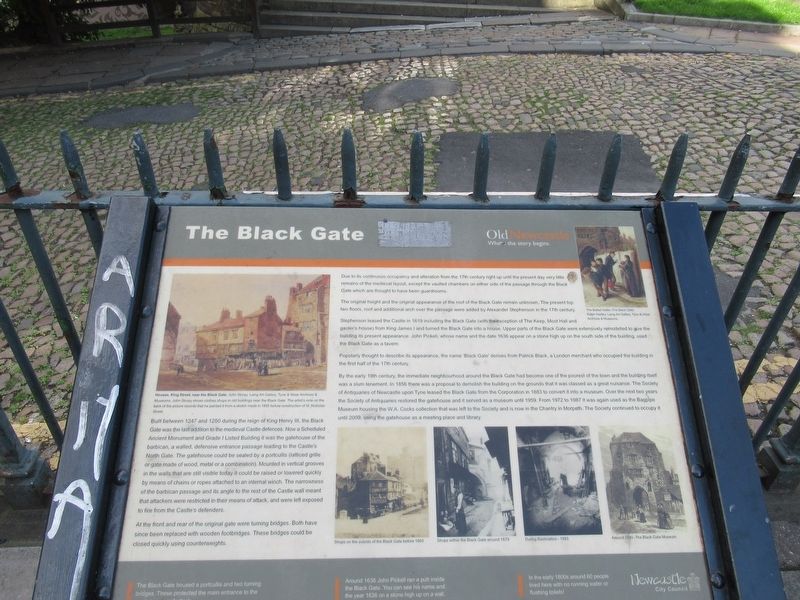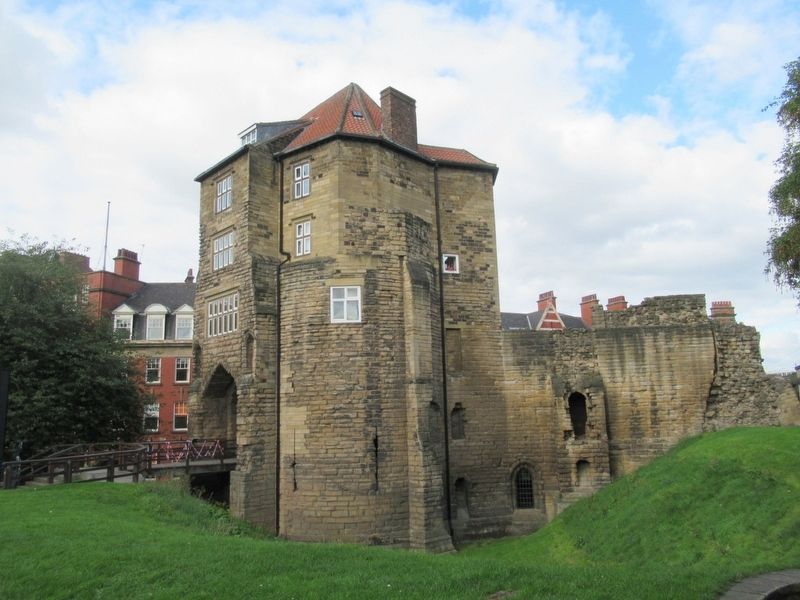Newcastle upon Tyne in Tyne and Wear, England, United Kingdom — Northwestern Europe (the British Isles)
The Black Gate
The Black Gate
Built between 1247 and 1250 during the reign of King Henry III, the Black Gate was the last addition to the medieval Castle defences. Now a Scheduled Ancient Monument and Grade I Listed Building it was the gatehouse of the barbican, a walled, defensive entrance passage leading to the Castle's North Gate. The gatehouse could be sealed by a portcullis (latticed grille or gate made of wood, metal or a combination). Mounted in vertical grooves in the walls that are still visible today it could be raised or lowered quickly by means of chains or ropes attached to an internal winch. The narrowness of the barbican passage and its angle to the rest of the Castle wall meant that attackers were restricted in their means of attack, and were left exposed to fire from the Castle's defenders.
At the front and rear of the original gate were turning bridges. Both have since been replaced with wooden footbridges. These bridges could be closed quickly using counterweights.
Due to its continuous occupancy and alteration from the 17th century right up until the present day very little remains of the medieval layout, except the vaulted chambers on either side of the passage through the Black Gate which are thought to have been guardrooms The original height and the original appearance of the roof of the Black Gate remain unknown. The present top two floors, roof and additional arch over the passage were added by Alexander Stephenson in the 17th century. Stephenson leased the Castle in 1619 including the Black Gate (with the exception of The Keep, Moot Hall and gaoler's house) from King James I and turned the Black Gate into a house. Upper parts of the Black Gate were extensively remodelled to give the building its present appearance. John Pickell, whose name and the date 1636 appear on a stone high up on the south side of the building, used the Black Gate as a tavern.
Popularly thought to describe its appearance, the name 'Black Gate' derives from Patrick Black, a London merchant who occupied the building in the first half of the 17th century.
By the early 19th century the immediate neighourhood around the Black Gate had become one of the poorest of the town and the building itself was a slum tenement. In 1856 there was a proposal to demolish the building on the grounds that it was classed as a great nuisance. The Society of Antiquaries of Newcastle upon Tyne leased the Black Gate from the Corporation in 1883 to convert it into a museum. Over the next two years the Society of Antiquaries restored the gatehouse and it served as a museum until 1959. From 1972 to 1987 it was again used as the Bagpipe Museum housing the W.A. Cocks collection that was left to the Society and is now in the Chantry in Morpeth. The Society continued to occupy it until 2009, using the gatehouse as a meeting place and library.
The Black Gate housed a portcullis and two turning bridges. These protected the main entrance to the castle in case of attack.
Around 1636 John Pickell ran a pub inside the Black Gate. You can see his name and the year 1636 high up on a wall. Can you find it?
In the early 1800s around 60 people lived here with no running water or flushing toilets!
( photo captions )
Houses, King Street, near the Black Gate, John Storey. Laing Art Gallery. Tyne & Wear Archives & Museums. John Storey shows clothes shops in old buildings near the Black Gate. The artist's note on the back of the picture records that he painted it from a sketch made in 1855 before construction of St. Nicholas Street.
The Ballad Seller, The Black Gate; Ralph Hedley. Laing Art Gallery. Tyne & Wear Archives & Museums.
Shops on the outside of the Black Gate before 1860
Shops within the Black Gate around 1879
During Restoration – 1883
Around 1890 – The Black Gate Museum
Topics. This historical marker is listed in this topic list: Forts and Castles. A significant historical year for this entry is 1247.
Location. 54° 58.157′ N, 1° 36.657′ W. Marker is in Newcastle upon Tyne, England, in Tyne and Wear. Marker can be reached from the intersection of St. Nicholas Street and The Black Gate, on the right when traveling north. Located at Newcastle Castle. Touch for map. Marker is in this post office area: Newcastle upon Tyne, England NE1 1RQ, United Kingdom. Touch for directions.
Other nearby markers. At least 8 other markers are within walking distance of this marker. Turning Bridge (here, next to this marker); a different marker also named The Black Gate (here, next to this marker); The Barbican (a few steps from this marker); St. Nicholas Cathedral (a few steps from this marker); William Heron (a few steps from this marker); The Heron Pit (a few steps from this marker); Medieval Castle (within shouting distance of this marker); Norman Castle (within shouting distance of this marker). Touch for a list and map of all markers in Newcastle upon Tyne.
Also see . . . Newcastle Castle. (Submitted on November 23, 2018, by Michael Herrick of Southbury, Connecticut.)
Credits. This page was last revised on January 27, 2022. It was originally submitted on November 23, 2018, by Michael Herrick of Southbury, Connecticut. This page has been viewed 271 times since then and 46 times this year. Photos: 1, 2. submitted on November 23, 2018, by Michael Herrick of Southbury, Connecticut.

